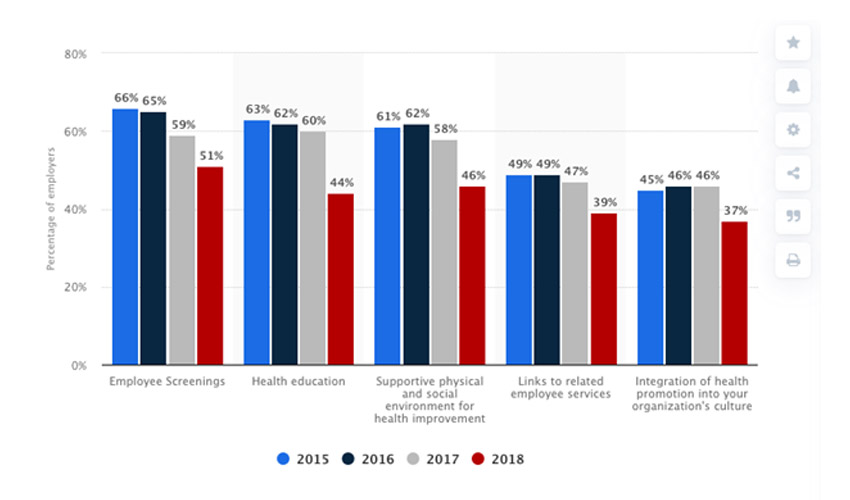
Healthy individuals tend to be happier, more engaged and productive employees.
But our lifestyles today are highly demanding, making optimum health something of a challenge to achieve and maintain. By and large, employees are ‘always on’, and are required to juggle more balls than ever before.
Thinking of the global nature of business, it’s now commonplace for employees to be on calls or in virtual meetings well before or after traditional business hours to make up for time differences; many employees spend hours daily commuting to work and back home; and, those who enjoy the perk of working remotely may not always do well at switching off.
Further, while technology has sped up certain processes, employees may still feel that they’re expected to do more than what can be achieved in a standard work day, which is often compounded by shrinking teams as a result of economic influences.
It’s plain to see that achieving a work-life balance has become something of an art – and modern employees expect organizations to support them in this quest. In fact, this is true of 87% of employees according to a Glassdoor survey.
The picture of wellness programs in the workplace
As we recently saw, today’s employees (especially Millennials, who are now the largest generation in the US workforce) are drawn to perks that support their quality of life. Generally speaking, they’re most attracted to rewards that are personalized, and are appropriate to their circumstances, their age and their lifestyles.
In spite of the high demand for companies to support employee wellbeing and help their staff look after their health, only 58% of US employees say their company offers wellness programs, according to statistics shared by Gallup.
The below graph indicates the percentage of employers who stated that select elements were offered in their company’s wellness programs in the US from 2015 to 2018. Alarmingly, there appears to be a downward trend with only 37% of employers integrating health promotion into their organization’s culture in 2018.

How can you enhance employee wellbeing in your organization?
Physical health
It’s a well-known fact that stress has a negative impact on individuals’ wellbeing. While much of the responsibility to lead a healthy lifestyle and offset stress lies with the individual, there is a fair amount that organizations can do to foster employee wellbeing.
Organizations can underpin work-life balance by encouraging employees to clock off at a given time, especially when working remotely; discouraging work over weekends, where possible; and regularly reminding employees of the benefits that sufficient sleep, downtime, exercise and a nourishing diet provide. After all, these factors all impact employees’ ability to perform and remain engaged at work.
Organizations can make a point of identifying when employees are regularly logging overtime and, where possible, could offer employees time off in lieu of additional time worked.
Depending on your organization’s budget, you could also introduce ergonomic furniture in your office, offer gym membership benefits and ensure that there are healthy food options available to staff if you have a cafeteria, snack bar or vending machines.
Not everything that supports employee wellbeing has to add costs, though – something as simple as encouraging employees to take sick leave when they are genuinely ill may also support a greater focus on physical health within your organization.
Mental health
According to information provided by the American Psychiatric Association Foundation, One Mind at Work and Mental Health America, employers can play a role in impacting employees’ mental health and wellbeing positively. This in turn can also improve productivity, retention, general healthcare costs, and so on. To find out more and take the Workplace Mental Health Assessment to gain insight and help you build a mentally healthy culture, click here.
When it comes to general morale, employers can boost it by offering recognition where it’s due, and showing appreciation and gratitude towards employees. Instilling a culture of real-time feedback helps employers keep channels of communication open and assists employees in knowing whether they’re on the right track.
Ensuring that employees have realistic workloads also supports a positive morale. This can be facilitated by carrying out performance management and workload forecasting initiatives. Ultimately, many employees want to know that they’re contributing positively and feel a sense of accomplishment from the work they do. You can help them work more efficiently and productively, and with higher motivation levels, with the right tools.
Additionally, it’s important to honestly assess whether there are any traces of a toxic environment within your organization. This kind of atmosphere can have significant effects on employees’ relationships and their wellbeing. Fortunately, it can be fixed – read more here to find out how.
You might also like: Be happy at work – dopamine and the science behind success
Financial health
Financial concerns can weigh heavily on individuals, but you can lighten the load by offering support through tailored programs at your organization. You may want to start by understanding employees’ financial health challenges via surveys or focus groups, for example, all the while ensuring respect and privacy.
Once you have an idea of the concerns your staff members face, you can reach out to the appropriate service provider to discuss solutions that will help employees plan, save and spend wisely.
You might consider introducing policies that help employees cover healthcare costs or plan towards their retirement. You could also rely on qualified individuals within your organization or an external service provider to host workshops that offer valuable education on budgeting, taxes or other financial matters.
Foster a culture of wellbeing
To successfully support your employees’ in looking after their wellbeing, it’s imperative to ingrain these initiatives in your organization’s culture. It takes more than attractive benefits to retain employees, and helping employees stay healthy and achieve their wellness goals will go a long way in earning their appreciation and loyalty. And remember, healthy employees are more likely to be happy, engaged and productive.
Find out more about how we support various aspects of your wellness strategy with our easy-to-use talent management platform.